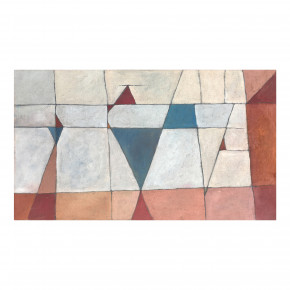Peinture*
Description
Executed in: 1958
Medium: Oil on canvas
Size: 88,4 x 115 cm
Signed ‘Kantor’; Signed and dated ‘T.KANTOR / CRACOVIE / X 58’
Provenance
Galerie H. Le Gendre, Paris; Malborough Fine Art, London; Kolekcja Marc M. Spiegel, London; New York, Christie’s Private Sale Ltd; Private collection, Europe
Description
Thadeusz Kantor was a stage director, creator of happenings, painter, set designer, writer, theoretician, actor, and lecturer. Throughout the world, Tadeusz Kantor is best known as an outstanding and highly original figure of 20th century theatre, as well as the creator of his own theatre group and of productions infused with a poetry derived from the artist's own complex Galician origin. Throughout his life he strove to combine a variety of activities and artistic expressions, and this resulted in his very complex oeuvre. This is also true of his work in the visual arts, where he worked mostly as a painter and pioneer of happenings. Kantor’s powerful visual language in staging and symbolism stemmed from the fact that he saw himself as a painter working in theatre; at one point he even called himself a trespasser in the theatrical world. Objects and symbols were incredibly important to Kantor, both in theatre and in painting. Kantor and Cricot 2 performed in the most distinguished theatres of the world, while his visual work was presented in many institutions for contemporary art, such as the Tate Modern, documenta, the Centre Pompidou in Paris and Manifesta.
Kantor's painting was inspired by the contemporary art he encountered during his sojourns abroad, mostly in Paris and in New York. His paintings experimented with art informel, Dadaism, and conceptual art, and consequently began to use new materials like emballages and other found material. In this way, Kantor’s paintings also encouraged an intimacy between the artist and the viewer. In many of his series, he affixed various materials to his canvases. He experimented with consumer participation by inviting his buyers to add more paint or affix other objects to his canvases, as if collaborating with Kantor. In later works, the artist merged sculpture with painting, by, for example, attaching sculpted limbs to bodies he painted on canvases.
Exhibitions
Lech Stangret, "Tadeusz Kantor. Malarski ambalaż totalnego dzieła.", Art +Edition Adam K. Dominik, Kraków 2006, repr. s. 29; Ryszard Jeremi Kluszczyński, “Od Michałowskiego do Fangora. Nowoczesne Malarstwo Polski”, wyd. WBC, Kraków 2016, repr. s. 407
The works of art which are subject to artist resale royalty rights ('droit de suite') are marked with an * in the description of the work of art. The amount of the royalties is calculated using a sliding scale of percentages of the Hammer Price.
Lots featured on Ans Azura’s platform may be subject to export regulations in the country where they are located and import regulations in the country where they will be shipped to. The location of each Lot is marked in its description.You are responsible for ensuring that you understand and comply with all relevant laws or regulations applicable in relation to the export or import of any Lot that you intend to purchase.
By registering to bid in auctions and by bidding on the Ans Azura platform you agree to the Bidder’s and Buyer’s Terms and Conditions which you may consult here. Please read these Terms and Conditions carefully. By bidding you accept personal liability to pay the Purchase Price consisting of the Hammer Price and the Buyer’s Premium plus the applicable Buyer's Expenses. Please note that the Total Cost Calculator will display the amount including the estimated Buyer’s Premium, exclusive of related artist resale royalties and any shipping expenses and all duties, taxes, VAT, and/or custom processing fees payable by the Buyer.

